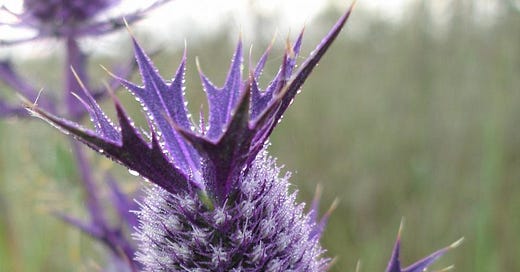LifeScapes has been my personal blog since the late 1990s—a record of what’s going on in our home ground, our corner of the Texas Hill Country. This is my second LifeScapes post here at Substack. If you’re a little late to the party, you’ll find the first post here. It describes this place we call home and suggests ways that you can connect with yours.
Whatever your home ground, every month blooms with its own native beauty. Here at MeadowKnoll, September and the autumn equinox bring eryngo (Eryngium leavenworthii), a bristly, intricately sculptured wildflower that punctuates the fields with a brilliant purple. You might be thinking that it looks a lot like a thistle. But it isn't, although one of its cousins (Eryngium castrense) is called coyote thistle—which makes sense when you remember that Coyote is a mythological trickster, always attempting to deceive his gullible friends into believing he's something else. Eryngo pretends it’s a thistle for a reason.
A wildflower with blooms that range from pale greenish-white to deep purple, eryngo belongs to the carrot family. It's a perennial here—an annual farther north—that grows readily from seed. The tiny flowers are protected by fierce bracts that likely evolved as a stiff defense against grazing animals that might nip it in the bud, thereby preserving precious nectar and pollen for the pollinators that ensure its production of seed. (Think trickster.) In a Lancaster County PA experimental garden, for instance, eryngo ranked in the top third of plants with an irresistible appeal for foraging bees, wasps, flies, butterflies, moths, and beetles.
But there’s more to this prickly plant than pretty. It’s tasty and said to be an aphrodisiac.
Keep reading with a 7-day free trial
Subscribe to Thyme, Place & Story to keep reading this post and get 7 days of free access to the full post archives.




